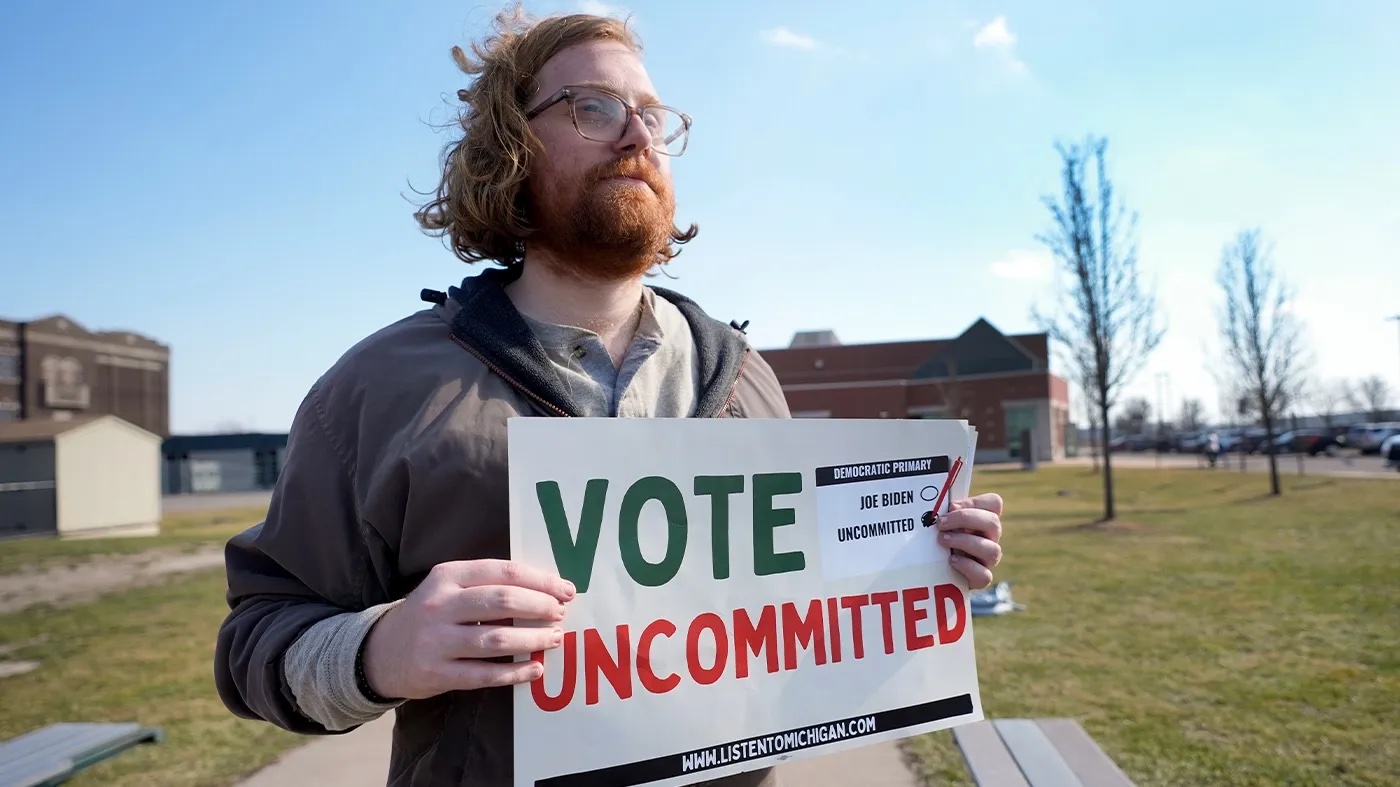
The uncommitted movement—the campaign to get voters to mark “uncommitted” on their Democratic ballots as an act of protest against President Joe Biden’s Gaza policy—has been an unexpected feature of this year’s presidential primary. The movement has been spearheaded by organizations like Listen to Michigan, which mobilized voters in protest of the administration’s material support for Israel’s war against Gaza.
As headlines over the last month have shown, the uncommitted movement has spread since scoring over 100,000 votes in Michigan at the end of February. That ensured two delegates from the state are headed to the Democratic National Convention with a directive to vote “uncommitted.”
Since then, the movement has gained seven delegates out of Hawaii and 11 from Minnesota. Although Biden has already taken 1,968 delegates, more than enough to secure the nomination, the growing numbers of uncommitted votes tell their own story. According to The New York Times, the average Biden protest vote in primaries held so far sits at around 13%.
Generally speaking, primaries have lower voter turnouts and tend to be low-stakes when a party has an incumbent president in office. It’s worth noting also that protest votes are not uncommon against incumbent presidents from both parties. 2004 (Republican), 2012 (Democratic), and 2020 (Republican) all saw notable protest results during the primaries. So, what’s different now?
Two contrasting ways of reading the political nature of the current uncommitted movement are emerging. One looks at the numbers from various years and concludes there is little novel about the 2024 phenomenon. Another points to the coordinated nature of the uncommitted vote and the clear political purpose behind it, resulting in a very different conclusion about the implications it has for Biden’s (or Trump’s) re-election.
By the numbers
“Specific to Michigan, uncommitted didn’t perform much differently than it did in 2012, which is the nearest analog,” Adrian Hemond, CEO and founder of Grassroots Midwest tells People’s World.
“This year, uncommitted got slightly more than in 2012,” Hemond adds. “Not a statistically significant difference in terms of percentage. The absolute number of votes was greater, because overall more people voted in this primary than in 2012, but it polled roughly the same percentage.”
The similar percentage to 2012 is not the only thing of note, however. Other analysts have pointed out that the results in Michigan’s primary this year shared some similarities in pattern to the Hillary Clinton – Bernie Sanders race in 2016.
“When I look at where the focus on the uncommitted vote is in Michigan, the two congressional districts that were above the average were the 12th Congressional District—which is represented by Rashida Tlaib and has Dearborn in it—and the other is Debbie Dingell’s, which is the 6th District and has multiple universities,” Ed Sarpolus, a pollster based in Lansing, tells People’s World.
“Well, in 2016, where is Bernie Sanders getting all his votes? Minority communities and those under 35 who are going to college.
“The value of doing this for 52 years is that things don’t always surprise me,” Sarpolus quickly adds.
Given the similarity to previous primary results, though, the likelihood that Democrats will get the message that they need to change their tune might seem low. It could turn out to be true if, as consultants like Hemond have noted, the concerns of the general voting public turn out to be much more domestic compared to the more politically engaged primary electorate.
“From a political standpoint, of the things that are harming Democratic chances in November, this is pretty far down the list,” Hemond believes. “Separate from the two candidates—who are both deeply unpopular—most of what’s going to happen in the November election is going to come down to not just the performance of the economy, but the vibes of the economy.
“Economic performance has improved quite a bit over the last several months, but the vibes have not caught up to that. Democrats need that to happen in order to maximize their winning chances,” Hemond adds.
Analysts in the same camp as Hemond argue that the spotlight that the uncommitted movement is enjoying now will be momentary.
“It does send a message to the president that there is some dissatisfaction with his policy vis-à-vis the Israel-Hamas war, but I don’t think that is going to make the president change tack,” Hemond says.
“I think ultimately this conflict and how it impacts voting behavior is going to map pretty closely onto people’s existing political views,” he adds.
“Is it going to be harder for Biden to get those votes back in the fall? Yes, if things don’t change, I could see that happen,” Sarpolus explains.
By the people
“I have seen this before—I have seen us as voters not be excited about our candidate in the past, only to have Trump win, and, frankly, I voted uncommitted because this is the last tool we have to try to re-elect a Democrat for the presidential seat,” Detroit City Council Member Gabriela Santiago-Romero tells People’s World.
Given the timing and pace of developments, putting up an alternative candidate for the Democratic nomination in Michigan was not realistic. However, the strategy of the uncommitted movement is not so traditional anyway.
“We’re not here to tell people how to vote—the uncommitted movement is not about…putting Trump into office,” Listen to Michigan’s spokesperson and lead organizer Lexis Zeidan tells People’s World. “What it is saying is that we know how the average person feels, we know how voters feel, and we’re telling [Biden] to listen to us before [he] unravel[s] this democracy by handing the presidency over to Trump.”
Are Democrats listening, though? Before that question can be answered, another one needs to be addressed: What is different this time? Is the uncommitted movement just another flash-in-the-pan protest vote that the president and others will ignore?
Immediately after the primary in Michigan, pollster Richard Czuba said, “The Listen to Michigan campaign was extraordinarily successful at understanding that a bunch of national reporters would helicopter into Michigan and need to be spoon-fed a narrative.” Was he right? The movement has been met with endless headlines about how it won’t last, but wasn’t there already an established media narrative against so-called protest votes?
“I think what has worked against us for so long is the press, it is the narrative, and when you have someone with so much power—like pollsters—that can go out to major outlets and say things like, ‘These numbers mean nothing,’ it becomes a narrative people are willing to believe,” Zeidan says.
“I think we’ve done really well capturing the media in a way that has not been done before, and I think it’s our duty to continue the outreach and engagement, ensuring that the story doesn’t die out—it can’t die out.”
Clash of narratives
For the millions of Americans who are not wedded to either of the two major parties, the calculation often comes down to how they perceive the state of the economy and picking between the “lesser of two evils.” This election might end up being no different, and as Hemond has pointed out, these focal points can be decisive for a party’s chance at winning.
What might be different is the criteria that at least some segments of voters are using to approach the “lesser of two evils” question.
“People’s feelings about the economy and their personal finances tend to lag economic indicators by around six-ish months,” Hemond notes. “So, it is certainly possible that vibes about the economy and people’s financial situations will improve [by November]. Democrats need that to happen in order to maximize their winning chances.”
When the topic of the economy comes up, it is almost always a personal one and the question quickly expands into areas like job security, income growth, Social Security, media stories about the importance of stock market performance, retirement, etc. Government spending also comes up.
On all these issues, Biden and the Democrats have a record they point to—COVID recovery, infrastructure funding, efforts to confront inflation, plans to save Social Security and Medicare from Republican cuts, and more. But the administration’s military spending—from Gaza to the new Cold War with China to Ukraine—stands out as a contrast to the story of domestic recovery.
“Across the country, we are seeing the U.S. spend billions of dollars on war while we are dealing with housing, infrastructure, and food crises,” Santiago-Romero points out. “I think Americans are tired of us spending war and not funding our communities.”
“I think what people forget is that it’s all interrelated, and when you think about the fact that we can with the snap of our fingers take $95 billion to give in aid to foreign countries when you have so many issues within our own backyard,” Zeidan explains, referring to the Ukraine-Israel supplemental funding package that Biden requested from Congress.
“From healthcare to student debt to rent—these are issues that plague us no matter what your background is—these are issues that plague our country every single day.”
Some progressives might feel they’ve reached a breaking point, but would they actually consider turning to the other “deeply unpopular” candidate? Trump’s administration was also known for its war spending; managing and maintaining U.S. imperialism has always been a bipartisan affair. Furthermore, how effective is appealing to the “lesser of two evils” narrative these days?
“I don’t think that the Democratic Party or the president’s administration are hearing themselves when their response to the Listen to Michigan campaign was essentially ‘Do you want Trump to ban your family?’” Santiago-Romero explains. “They are not taking responsibility for what they’re doing, and instead they are pivoting to the ‘lesser of two evils’ narrative, and I think it’s disgusting to ask people to vote between bombs or bans.”
“What we hear is ‘What about Trump?’” Zeidan says. “We know what threat Trump poses: He moved the embassy to Jerusalem and gave it to Israel, he installed a Muslim ban—we don’t want Trump. We are doing the Democratic Party a favor by saying ‘This is what you need to do’ to protect this country from somebody like Trump.”
The uncommitted movement has undeniably captured the attention of the White House and the Democratic Party; the changing dynamics of the administration’s approach to the ceasefire question is proof of that. As the movement carries on, it faces not just a struggle to win votes but also a battle for the media narrative around its importance and influence.
The numbers people say the future is set and that the protests won’t matter. But those active in the ceasefire movement point to the ongoing slaughter in Gaza and the growing global opposition to it, as shown by the latest U.N. Security Council resolution that passed on Monday. For them, as long as U.S.-supplied weapons continue enabling the ongoing genocide in Gaza, there’s still work to do. The “uncommitted” don’t plan on being ignored.
As with all op-eds, this article reflects the opinions of its author.
We hope you appreciated this article. At People’s World, we believe news and information should be free and accessible to all, but we need your help. Our journalism is free of corporate influence and paywalls because we are totally reader-supported. Only you, our readers and supporters, make this possible. If you enjoy reading People’s World and the stories we bring you, please support our work by donating or becoming a monthly sustainer today. Thank you!










